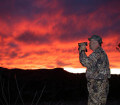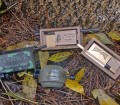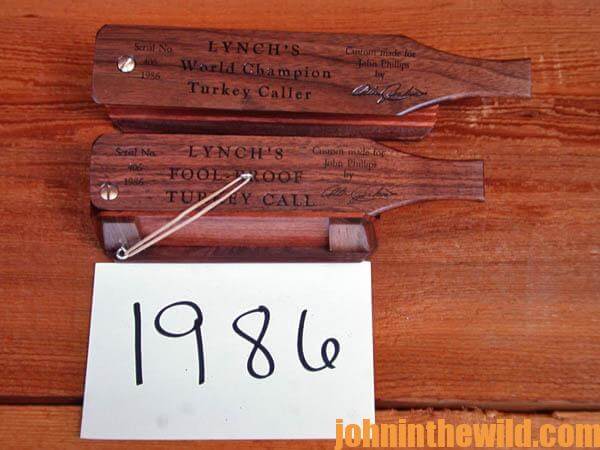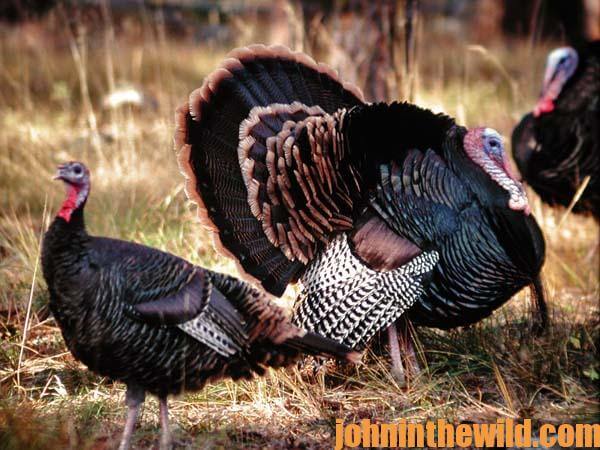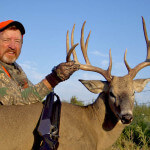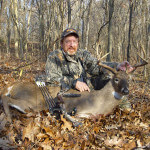John’s Note: The early colonists found turkeys so plentiful that hunters didn’t have to call in the birds to take them. A Massachusetts settler in the 1600s might see 1000 turkeys in a day close to his home. New York City in the mid-1700s held an annual Christmastime turkey shoot between where Park Row and the end of the Brooklyn Bridge lay today. The area just outside NYC at that time often held turkeys traveling in flocks of hundreds with some weighing 30 to 40 pounds each. Although the human voice was probably the first device ever used to call a wild turkey, Indians and settlers sometimes called turkeys by blowing across briar leaves to make yelping sounds. But even today, some proficient turkey callers use nothing but their voices to call gobblers.
No one knows exactly who invented the slate call. Perhaps some youngster scratched a stick on his slate board while doing his homework. Recognizing the slate made a sound much like a hen turkey, he may have dropped his slate board and broken it on purpose. Cupping a piece of slate in his hand and using a wooden peg, maybe he discovered what an excellent sound chamber his hand made when he scratched the peg across the slate.
From that primitive beginning, turkey hunters have watched the slate call change drastically. M.L. Lynch (see Day 1) developed a method of putting a slate on top of a hollow box that the hunter held in his hand and using a small peg for a striker. This Lynch Jet became one of the first commercial slates. Then in the early 1980s, Lewis Stowe of Gastonia, North Carolina, brought to the market a round slate that fit easily in the hunter’s hand. He replaced the wooden sound chamber with a plastic one. The next radical step in slate calls included plexiglass slate calls and double-slate calls. After replacing the slate with a piece of plexiglass, the hunter used either a plexiglass or a wood striker. The double-slate calls fashioned from plastic or slate had a second piece of either plexiglass or slate situated lower in the sound chamber.
The tube call has grown in popularity. The tube call evolved from a modified snuff-can call. In years past, hunters cut the lid of a snuff can in half and stretched a piece of rubber over the opening in the snuff can. Then by blowing air over the rubber and metering that air, the hunter could make the sounds of a wild turkey. With the snuff-can call, a hunter could generate louder sounds than he could with either the box or the diaphragm call. In recent years, call manufacturers like Harold Knight and David Hale of Knight and Hale Game Calls ( HYPERLINK “www.knightandhale.com” www.knightandhale.com) replaced the snuff can with a plastic tube for a modern-day tube call.
Wingbone Call:
Hunters have modified the traditional wingbone call, originally built by gluing together three different bones from a turkey’s wing to make a small, pipe-like call. Most turkey calls operate by blowing air through or over the call. With the wingbone call, however, hunters make the sound by sucking in rather than blowing.
Push Button Call:
In the early 1940s, 1950s and 1960s, outdoorsmen considered the ability to call the wild turkey a gift, bestowed on only the wiliest hunters with the best musical ears. Someone who possessed the gift would explain that, “A caller must spend hours in the woods listening to turkeys and then practice for years before sounding like a hen turkey. Most folks don’t live long enough or hunt hard enough to master the art of turkey hunting. Why, if I hadn’t started learning how to call gobblers right after I crawled out of my crib, I wouldn’t call in a single turkey.” But in the last few years, the mystique of calling the wild turkey has waned – especially with the new innovations in turkey calls. For instance, the push button call, a little box with a peg suspended by a round dowel, calls in many turkeys each season. The hunter holds the push button call in his hand and either pushes or pulls the dowel to cause the paddle to pass over the peg. With ease, even a beginning hunter can imitate a hen turkey. The hunter can cut, cackle, purr or yelp the same as on any other call.
To get John E. Phillips’ eBook, “The Turkey Hunter’s Bible,” click here.
About the Author
John Phillips, winner of the 2012 Homer Circle Fishing Award for outstanding fishing writer by the American Sportfishing Association (AMA) and the Professional Outdoor Media Association (POMA), the 2008 Crossbow Communicator of the year and the 2007 Legendary Communicator chosen for induction into the National Fresh Water Hall of Fame, is a freelance writer (over 6,000 magazine articles for about 100 magazines and several thousand newspaper columns published), magazine editor, photographer for print media as well as industry catalogues (over 25,000 photos published), lecturer, outdoor consultant, marketing consultant, book author and daily internet content provider with an overview of the outdoors.

